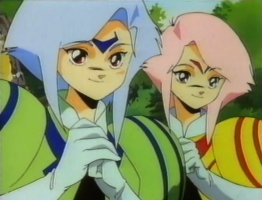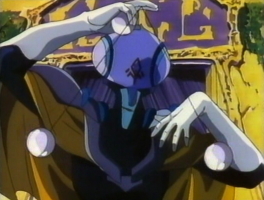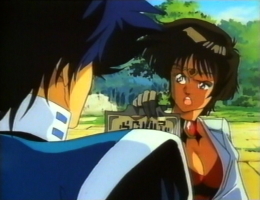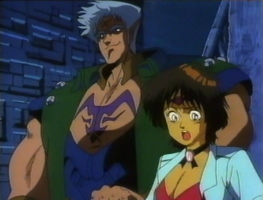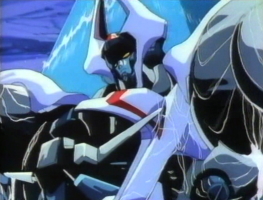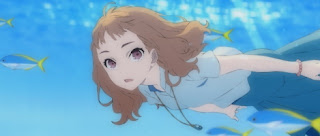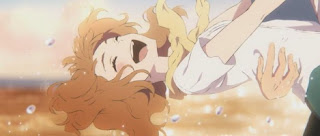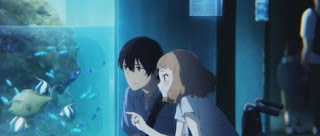Release Date: 30 April 1995
Format: PAL VHS, Japanese Dialogue with English Subtitles
Runtime: 48 mins
Catalogue Number: WEST042
Japanese Title: Makyo Gaiden Le Deus (Demon Frontier Legend Le Deus)
Japanese Production Date: 1987
I originally started this series on the utterly odd and obscure 1990’s UK based video distributor, Western Connection, back in February 2014 on another now defunct blog. It has been over two and half years since I wrote and completed the previous part of the series. Due to numerous issues, a fair part of it due to my own laziness, here we are, finally at the end. But before we start exploring one of the last titles the company released, I thought a recap would be in order (the original updated post can be found here); Western Connection was easily the oddball out of all anime companies based in the UK. Formed in 1992, it was pretty much a one-man company run by Yugoslavian immigrant Sasha Cipkalo, with initial releases being an utterly eclectic range of mostly foreign language films as well as select titles aimed at the gay market. In 1993, somehow Cipkalo got the rights to an obscure, arty period piece anime called “The Sensualist”. This was an anime based upon a 17th century Edo era book, so it wasn’t exactly the most commercial title on the market.
The early to mid 1990’s was of course the era of “Manga Videos” in the UK, with some of the bigger selling VHS tapes selling in the tens of thousands. Even smaller titles averaged over 4,000 copies per tape. Unwittingly Cipkalo had become a player in this market and was utterly surprised when “The Sensualist” had become his biggest seller to date. Realising he had to act fast to capitalise on the anime trend, but having little idea what the market wanted, Cipkalo bought up relatively cheap licences, mostly from Toho and sublicenses from French company Ucore. As result, over half the titles in their anime catalogue were never released by any other company in English and were so obscure or niche, they were never reissued in Japan after their initial home video releases. While arguably most of these anime titles weren’t exactly stellar by anyone’s definition, the vast majority of them were quite interesting and entertaining. Today I will be looking at one of their final releases; “Ladius”.
Seemingly set on a post-apocalyptic Earth, some several hundred years in the future, we are introduced to a young man named Riot and his two female companions, Spica and Seneca, who are traveling during the night on their oddly designed mechanical transport. The group have obtained a type of lens which is part of a collection of five known as the Eye of Zalem. Riot is in search of all five of these "lenses", which will give him the power of Rido. Long ago a race known as the Quall hid away this power that could bring people back to life or cause death and destruction. But before they can travel to their next destination, Zalem, Rido informs his companions that will need to make a detour to the city of Zigoa. The next morning in the Shirale Valley at the house of a descendent of Zalem, a group of cyborgs collectively known as Demsters rough up the elderly occupant named Randal and his son to discover who they gave their lens to. After Randal's son succumbs to their violence and tells them they gave the lens to Riot, the Demsters kills both of them and then set out to find Riot.
Riot and the two girls arrive in Zigoa to meet a young woman called Yuta La Caradeen in the local bazaar who works as a kind of soothsayer. Riot hands Yuta a letter in which Randal asks her to give him the lens, warning that possession of it only brings despair. Initially she is no mood to deal with Riot, but before any negotiation can begin, the Demsters attack her and Riot’s group, but eventual end up destroying most of her possessions much to Yuta's annoyance. Spica and Seneca manage to get the Demsters to retreat after letting off smoke bomb-like weapons called Hiss Candy. Yuta is furious at Riot as her shop is putterly destroyed, so she presents him with a bill for the damage. Riot tries to smooth out things by saying that if she lets him take the Eye of Zalem, she will be rich once he finds Rido. She makes a deal with him; he can have the lens, but only if she can travel with him to the ruins of Zalem.
Having been defeated, the Demsters return to their leader, Kaiser. Annoyed at their failure, he sends them out to capture both the lenes and curiously Yuta. Kaiser believes she may be a link to Zalem. Meanwhile Riot and Yuta and his two companions are traveling through the countryside to the ruins of Zalem. The two girls give her a Jingu nut to eat, which she finds rather unpalatable. Later at stop off at a beach, where Riot hears the story of Yuta eating the Jingu nut and laughs. He explains that Spica and Seneca are artificial life forms called Plana who were created specifically to be partners for him. Jingu nuts are food they can only eat and aren’t really for humans. The group decides to camp for the night. Over a campfire Riot explains to Yuta that he wants the power of Rido in order to save his sister who is currently in a state of suspended animation after a vehicle accident.
The following day they finally arrive at the ruins of Zalem which is next to a large lake. While searching for the entrance, the group are attacked by the Demsters, this time in giant robots. They grab Yuta, hold her hostage and demand Riot give them the lenses in exchange for her safe return. Riot feels he has no choice in the matter and decides to give them the lenes he has in his possession. Predictably the Demsters renege on the deal and once they have the lenses in their hands. They fire missiles at Riot, leave him for dead and head back into the lake from where they came. Luckily Riot and the girls are unharmed by the attack and head into the water in their transport in order to rescue Yuta. Initially they have no idea how to find her, but then Riot remembers that she ate part of a Jingu nut, and the trace elements within it are trackable on their scanners.
Meanwhile in the at the entrance to Zalem temple which is located in a large cavern under the lake, the Demsters hand over Yuta and the lenses to Kaiser. Kaiser attempts to enters the temple after placing all of the lenses in place on an altar. But he soon discovers that he cannot enter the temple and realises that only a descendent of Quall people can release the seal on the entrance to the temple. He commands that Yuta be brought to him and tells her, much to her surprise, that she is actually a descendent of a Zalem priest. She initially refuses his demands to open the temple, so he hypnotises her to make her navigate through the temple according to his will. However, Riot, Spica and Seneca finally arrive and are about to mount a rescue plan to save Yuta and foil Kaiser's plans.
This is another one of those one shot OVAs that were common from the mid to late the 1980’s right through to the late 1990’s when the format started to wane in favour of late-night anime TV series. To be utterly honest, this show is quite derivative; we have the rather cocky hero, the feisty female lead, two cute arse-kicking ditzy side-kicks, an evil white-haired villain, his ruthless cyborgs and giant robots. The plot can be equally derivative; baddies who need a lot of killing to be truly dead, clichéd and cheesy anime dialogue, and to top it off it's set in a quasi-post-apocalyptic/fantasy setting. Yet despite all of that, I really liked it. It's executed with quite a lot of style and flair. The creative staff knew they weren't making a masterpiece, so they've just gone for pure fun. And it delivers in spades. I mean yeah, its trashy in vernacular of how someone might describe 1980’s B-movie genre cinema, but it's quite entertaining trash. And the best thing about it is that it doesn't insult your intelligence.
Even though it is a bit of clichéfest, there are some original elements s to the OVA. For example, Riot’s bandage wrapped around his left arm can be unfurled and serves as both a weapon and a rope like tool to scale walls for example. Of course, the key element which makes this show so fun is the rather excellent animation, which for it’s time is just a notch above most OVAs. It’s really fluid, on model and really well done. The titular robot of this show, Ladius, who doesn't appear until the last 10 minutes of the show, is highly reminiscent of “Dangaioh”. However, none of the mecha designers who worked on that OVA worked on “Ladius”. As the first episode of “Dangaioh” was only released two months before “Ladius”, it’s highly unlikely the mecha designers were influenced by those designs. Of note is the Japanese promotional material which proclaims that Rei Aran of “Iczer 1” was the character designer. While this is true in a sense, Rei Aran was actually the mangaka for an adaption of “Iczer 1” that appeared in manga anthology magazine “Lemon People”, but he was not involved in the anime version. Furthermore Hideki Tamura (key animator and also character designer for “MADOX-01” and “Dream Dimension Hunter Fandora”) cleaned up Aran’s designs for the animation.
The director of this OVA was Hiroshi Negishi whose name should be familiar to fans of 1990’s anime. Some of his more famous creations include "Master of Mosquiton" and the "Saber Marionette" series ("Saber Marionette R", "J", "J to X"). He also directed "K.O. Century Beast Warriors", "Knights of Ramune & 40", "Misaki Chronicles", "Tekkaman Blade", "Sonic Soldier Borgman", "Burn Up W", "Shadow Skill" OVAs and "Amazing Nurse Nanako. Also on board for this OVA is screenplay writer Hideki Sonoda who has mostly done work on the "Pokémon" movies and TV series. Also working on the screenplay was Hiroyuki Kitakubo, who has had an amazing career. He helped with animation on "Urusei Yatsura" when he was only 15, was director on the first OVA in the infamous "Cream Lemon" series, and directed "Blood: the Last Vampire", "Roujin Z" and the "A Tale of Two Robots Chapter 3: Foreign Invasion" segment from "Robot Carnival".
The voice cast is quite good too with Kazuki Yao (Shinobu Fujiwara in “Dancouga”, Judau Ashta in “Gundam ZZ”, Franky in “One Piece”) as Riot, Yuko Mizutani (Leina Stol in “Machine Robo”, Mihoshi in “Tenchi Muyo!”, Pinoko in “Black Jack”) as Yuta, Norio Wakamoto (Shapiro Keats in “Dancouga”, Vicious in “Cowboy Bebop”, Charles Zi Britannia in “Code Geass”) as Kaiser, and Sho Hayami (Maximilian Jenius in “Macross”, Nicholas D. Wolfwood in “Trigun”) in a bit part as the mysterious leader of the Demsters. However, Seneca’s voice actor, Toshimi Nakamura, is pretty abysmal. Unsurprisingly this is her only credited role in an anime, and I cannot find any other information about her on the web. I sort of suspect this was Toshimi’s only real venture into the world of commercial Japanese entertainment.
Quality issues as per usual are a problem with this tape. Apart from the low-quality VHS tape used, as per the vast majority of Western Connection titles, subtitle timing is a major problem, though it’s not quite as bad as some of their other titles. The packaging only shows two small pictures on the back of the cover which are both of the robot Ladius, plus, as usual, a synopsis taken from the review of the OVA from UK anime magazine “Anime FX” (formerly “Anime UK”). But unlike other tape covers from the company, this time the magazine's work goes uncredited. I suspect that Western Connection and Anime UK had some sort of deal going on in terms of recycling reviews for their covers, as Jonathan Clements translated for both companies. Honestly though, I wouldn't be surprised if Western Connection didn’t just blatantly steal the text from the magazine. The cover uses the art from the original character designer Rei Aran which also appeared on the Japanese video releases, which is why Yuta looks quite different from the animation design. The nudity is in line with Aran’s primary work in “Lemon People”, which was an adult publication, although there is no nudity in the OVA itself.
If you’re huge fan of OVAs from this period, don’t hesitate to track down a copy of “Ladius”. This show was released when Western Connection was gasping its last breaths of air (in fact I believe it was the second to last anime title they released), and is pretty much impossible to find now. Unfortunately, this show never got a re-release on DVD or blu-ray in Japan or anywhere else in the world. Recently I have not been able to find copies on VHS, VHD or laserdisc on Yahoo! Auctions Japan. In fact, the rather nice soundtrack album, or in fact any other merchandise from the show, is now extraordinarily hard to find. The only readily available “Ladius” item seems to be the 1990's VHS release by Italian video company Yamato. Coupled with this is the lack of information on the web about the show, either in English or Japanese. I feel a lot of these old OVAs are just going to disappear and never be seen again. The OVA market created some weird and wonderful shows and some great experimentation that we don't see now days. A great deal of this older material never even made the leap to DVD let alone blu-ray and will never be re-issued. Sure, most of it isn't the pinnacle of anime, but it'd be nice to save some of these titles from obscurity.
And this wraps up my series on Western Connection. As I previously stated at the beginning of this series, after a final batch of releases from the company in mid 1995, nothing more was issued from the company thereafter. Late into 1995 and into 1996, the news sections of “Anime FX” magazine stated that new titles such as “Darkside Blues” and the remaining unreleased OVAs for “Hummingbirds” and “Devil Hunter Yohko” were due to be released in 1996. However, the months went by and not a peep was heard from Western Connection and they eventually faded from the minds of UK anime fandom. Finally, unfortunately this series will be ending on a sour note. I was contacted by someone in the UK who was working on a book and website dedicated to the history of UK anime releases. I found out from him that Western Connection owner, Sasha Cipkalo, was rather upset about what I had written about his company, which surprised me as these events and releases are from over a quarter of a century ago. In my opinion I thought I was quite mild and fair in my writings on the company and their products. I am deeply disappointed with Sasha’s take on my posts. This series was never a criticism of Sasha himself. I only ever meant to celebrate and highlight the delightfully odd anime titles he brought over for an English language audience to discover and experience.
Note: This post is based on previously published versions posted on the defunct “Lost World of Anime” website and blog in 2004 and 2009.
My new and old writings on anime,tokusatsu, music, local theatrical releases, the occasional look back at my visits to Japan and life in general
Saturday, June 26, 2021
Saturday, June 12, 2021
Anime On the Big Screen: “Josee, the Tiger and the Fish”
Venue: Hoyts Belconnen, Westfield Belconnen, Level 3, 18 Benjamin Way, Belconnen, ACT
Date: Thursday 10 June 2021
Distributor: Madman Entertainment
Format: Digital Projection, Japanese dialogue with English subtitles
Length: 98 minutes
Production Date: 2020
Currently on Home Video in English (as of writing): No
I know it’s been a long time since I have written anything. Work has been pretty relentless and I haven’t been feeling all that motivated to write really. I’ve made few aborted attempts to write, but nothing has been finished or is worth publishing. Also there haven’t been many anime films coming to cinemas either. This particular film was originally slated to screen in April but was delayed two months for unknown reasons. I noticed Hoyts in Belconnen was screening it, so I decided for a change of pace to go there instead of visiting Dendy in the city. After a quick bite to eat, I headed into the 6:20pm session, but soon discovered I was literally the only one in the cinema! Luckily two young blokes came in during the opening title sequence so I ended up having some company. I just can’t believe Hoyts is making any money off these screenings. Anyway, let’s talk about the film;
Tsuneo Suzukawa, a man in his early twenties, is working part time in a scuba diving shop/café in Osaka. He is utterly obsessed with diving and hopes to study overseas in Mexico in order to continue that passion. As a result, Tsuneo lives a frugal life as he saves every yen he can for his future studies. His work colleague, Hayato Matsuura, constantly berates him for not living in the moment having more fun at his age. His other work colleague, Mai Ninomiya, secretly has a crush on Tsuneo, but seemingly can’t work up the courage to ask him out, even though the young trio often go diving together and out drinking after work.
Walking home after work in the early evening, Tsuneo sees a young woman in a wheelchair hurtle uncontrollably down the slope of hill. Though he tries to stop her, she is flung put of her wheelchair and he accidently ends up breaking her fall and both end up on the ground. Her grandmother eventually catches up with her and thanks Tsuneo for saving her. The grandmother states that someone pushed her granddaughter downhill while she was distracted. The granddaughter is not all impressed with the situation and calls Tsuneo, who is still slightly in shock, as pervert for still clinging on to her. The grandmother decides that after this incident there will be no more walks for a long time as the world is a scary place that could hurt her. The granddaughter is of course upset with this.
Calling it a day, the pair walk home with Tsuneo unintentionally flowing them as they are heading in the same direction as his apartment. This of course does not impress the granddaughter who has seemingly taken a great dislike to him. Arriving at the front door of their house, the grandmother invites him in for dinner, which as a cash strapped student he gleefully accepts. The grandmother introduces herself as Chizu Yamamura and her granddaughter as Kumiko Yamamura, though she corrects her and proclaims her real name to be Josee. Josee's parents had died when she was young and her grandmother took her in as she did not want her to be put in an institution. Although Josee seems to despise him Chizu suggests in order to make more money for his overseas studies he should work as a caretaker for Josee while she is away from the house. Although initially reluctant, he decides to take on the job. Chizu only has two rules; Josee cannot leave the house and he must do whatever Josee tells him to do.
Things don’t go well. Josee ends up holed up insider her bedroom, ignoring him and either reads most the time or tells him to go home. When she does speak to him, she orders him to do absurd duties such as counting the threads in a tatami mat or collecting four leaf clovers for her. He later complains to his colleagues when they go out drinking. They eventually suggest to him that maybe the money isn’t really worth the pain of looking after Josee and maybe he should quit. When he later shows up at the house to tell them that he is quitting, he discovers no one seems to be at home. He goes into her room to look for her and is astonished to see her artwork of the ocean. Tsuneo is later informed by Chizu that Josee has gone missing. He searches everywhere for and eventually finds her. She states she wants to go the ocean as she has never been there. Feeling sorry for her being cooped up in the house all the time, he eventually relents and takes her there, even though she has a couple of bad experiences with people at the train station.
She has always wanted to see if the sea really tasted salty as her deceased father once told her. Though she insists crawling to the water’s edge, Tsuneo picks her up and caries her as he walks into the surf. Water splashes on her face and she tastes the salt and begins to laugh. After this unplanned excursion, Tsuneo and Josee take trips out into the city every day, and she experiences things she has never done before, which improves her outlook on life, even if Chizu doesn’t want her to go out at all. The pair go to the aquarium where they see a Clarion Angel fish. Tsuneo explains he saw this fish at a pet store when he was young and his dream is to see it in person off the coast of Mexico. A trip to the library brings a chance encounter and a new friendship with a young librarian named Kana Kishimoto. Though Josee is a little stand offish, the two bond over their love of the works of Françoise Sagan, and we discover that the name Josee is actually a character from one of Sagan's novels.
However, a trip to Tsuneo’s workplace doesn’t go well, with Josee, who has developed a crush on Tsuneo, becoming jealous when Mai discusses a workplace matter with him. She proclaims that she wants to leave and she has a fight with Tsuneo with leads her to abruptly leave in huff and return to her house by herself. Tsuneo later receives a call from Chizu advising his services are no longer required. He is utterly confused and frustrated at the turn of events. He and Josee later reconcile, but Tsuneo has been accepted by a Mexican university and he will be heading over then in a few months’ time. However, two tragedies will change the course of both their lives forever.
This film is based on a short story published in 1984 by Seiko Tanabe who was best known for her romance and historical novels as well as her essays. It does seem odd that a short story from over thirty-five years ago would be given an anime adaptation now. I suspect the interest in this work was due to the fact Tanabe died in June 2019. “Josee, the Tiger and the Fish” is one of her more popular works. Oddly a Korean live action theatrical feature adaptation of the story, titled “Josée”, was also released in the same month as this film. I suspect this story is also popular in Korea as the anime film debuted at the 25th Busan International Film Festival two months before it’s Japanese theatrical release. This film does follow the plot of the book closely for the first half of the film as far as I can figure out, then diverges greatly for the second half of the film.
A second live action film adaptation released in 2003 also diverges greatly from the short story with Josee being wheeled around in a pram instead of a wheelchair and Tsuneo and Josee actually having sex in the film, something which most anime shy away from, which seems at odd with constant criticisms in some quarters against anime that it has too much sexual content. This adaptation was helmed by animation studio Bones with Kotaro Tamura, who has done little of note except “Noragami”, directing. Interestingly, Sayaka Kuwamura, who has only worked on live action dramas and films previously, was brought on as screenwriter, because the producer and director felt the original story was more like a live action film and the same type of screenwriting would suit it. Mangaka Nao Emoto (“O Maidens in Your Savage Season”) did the original character designs and Haruko Iizuka (“Little Busters!”, “Tamayura”, “School-Live!”) cleaned them up for animation. Rounding out the staff was Evan Call (“Violet Evergarden”) who scored the soundtrack.
For me, the film was a little bit on the average side. Despite the use of a screen writer from the live action film and drama world, it was filled with a lot of clichés and tropes you’d find in a typical romantic comedy of this type. Josee herself is a stereotypical Tsundere who bullies the heck out of Tsuneo. While I understand that he would want to keep the job looking after Josee, but you’d think he would put his foot down at some of her absurd requests right from the get go. Josee constantly belittles him by calling him the “caretaker”, though by the end of the film it becomes more of a playful nickname. The film also feels rather old fashioned, both in how disabled people are treated by the public and Tsuneo’s attitude to work. Neither feel true to modern day Japan or the values of modem Japanese, but perhaps this can be chalked up to the era the source material was written in. The eventual love triangle, which does rear its head by the half way mark, also feels terribly cliched and unoriginal.
But as the film progresses it does improve. The new material not present in the original story does change it for the better. Not wanting to give away spoilers, but the change in plot does put Tsuneo and Josee on an equal footing, especially after Josee accuses him of being ableist. One of the main themes of this film is of course Tsuneo coming into Josee’s life and exposing her the wonders of the outside world which Chizu tried to shield her away from. Stories of mermaids are used a metaphor for Josee’s dreams to be free of her disability and live a normal life. Early on there is an extraordinarily beautiful sequence where Josee dreams the world is flooded and she becomes a mermaid freely swimming though the city. Other parts of the film show that the world is still somewhat hostile to Josee and want to force her crashing down to what others consider "reality". She is told that it would not be realistic to be able to live by herself by making money off her art. This segues into the other major theme of the story is following your dreams regardless of whatever happens or what obstacles are put in your way.
Despite the setting of Osaka, there are few of the typical clichés and stereotypes associated with the city that you'd find in anime or other pop culture. None of the usual landmarks like the Tower of the Sun or Tsutenkaku Tower are present. The Glico running man sign in Dotonbori is mentioned once, but that’s it. Despite author Seiko Tanabe’s love of using Kansai dialect in her works (her birthplace was Osaka and she spent her childhood there), I could not hear it in the film. Then again, I’m not a native speaker. Adding to what I’ve said previously, another issue I had with the film was Chizu’s overly protective attitude to Josee, which could be seen as abusive. This is totally glossed over in the film. Some of the actions taken by Josee in the later part of the film lacked logic, or more accurately, explanation (it was very hard to understand what she was thinking or planning to do). But the animation is utterly gorgeous most of the time and I did like the shift in the story during the second half which really filled out Tsuneo’s character and made him even more empathetic to Josee’s plight.
Summing up, this is a decent romantic comedy, but is held back by a lot of tropes and clichés of the genre. Kuwamura’s screenplay may go over well with an audience used to these types of live action films that are made by (and let’s be honest) a completely insular Japanese film industry that doesn’t respect the audience enough to give them something slightly challenging. However, I think international audiences for anime are far more sophisticated than that. There is a reason pretty much no live action Japanese cinema reaches western cinemas now days. I really think I can only give this film 6 out of 10 on balance. As per most modern anime films, there is additional footage during the end credits and afterward, so don’t leave the cinema early.
Date: Thursday 10 June 2021
Distributor: Madman Entertainment
Format: Digital Projection, Japanese dialogue with English subtitles
Length: 98 minutes
Production Date: 2020
Currently on Home Video in English (as of writing): No
I know it’s been a long time since I have written anything. Work has been pretty relentless and I haven’t been feeling all that motivated to write really. I’ve made few aborted attempts to write, but nothing has been finished or is worth publishing. Also there haven’t been many anime films coming to cinemas either. This particular film was originally slated to screen in April but was delayed two months for unknown reasons. I noticed Hoyts in Belconnen was screening it, so I decided for a change of pace to go there instead of visiting Dendy in the city. After a quick bite to eat, I headed into the 6:20pm session, but soon discovered I was literally the only one in the cinema! Luckily two young blokes came in during the opening title sequence so I ended up having some company. I just can’t believe Hoyts is making any money off these screenings. Anyway, let’s talk about the film;
Tsuneo Suzukawa, a man in his early twenties, is working part time in a scuba diving shop/café in Osaka. He is utterly obsessed with diving and hopes to study overseas in Mexico in order to continue that passion. As a result, Tsuneo lives a frugal life as he saves every yen he can for his future studies. His work colleague, Hayato Matsuura, constantly berates him for not living in the moment having more fun at his age. His other work colleague, Mai Ninomiya, secretly has a crush on Tsuneo, but seemingly can’t work up the courage to ask him out, even though the young trio often go diving together and out drinking after work.
Walking home after work in the early evening, Tsuneo sees a young woman in a wheelchair hurtle uncontrollably down the slope of hill. Though he tries to stop her, she is flung put of her wheelchair and he accidently ends up breaking her fall and both end up on the ground. Her grandmother eventually catches up with her and thanks Tsuneo for saving her. The grandmother states that someone pushed her granddaughter downhill while she was distracted. The granddaughter is not all impressed with the situation and calls Tsuneo, who is still slightly in shock, as pervert for still clinging on to her. The grandmother decides that after this incident there will be no more walks for a long time as the world is a scary place that could hurt her. The granddaughter is of course upset with this.
Calling it a day, the pair walk home with Tsuneo unintentionally flowing them as they are heading in the same direction as his apartment. This of course does not impress the granddaughter who has seemingly taken a great dislike to him. Arriving at the front door of their house, the grandmother invites him in for dinner, which as a cash strapped student he gleefully accepts. The grandmother introduces herself as Chizu Yamamura and her granddaughter as Kumiko Yamamura, though she corrects her and proclaims her real name to be Josee. Josee's parents had died when she was young and her grandmother took her in as she did not want her to be put in an institution. Although Josee seems to despise him Chizu suggests in order to make more money for his overseas studies he should work as a caretaker for Josee while she is away from the house. Although initially reluctant, he decides to take on the job. Chizu only has two rules; Josee cannot leave the house and he must do whatever Josee tells him to do.
Things don’t go well. Josee ends up holed up insider her bedroom, ignoring him and either reads most the time or tells him to go home. When she does speak to him, she orders him to do absurd duties such as counting the threads in a tatami mat or collecting four leaf clovers for her. He later complains to his colleagues when they go out drinking. They eventually suggest to him that maybe the money isn’t really worth the pain of looking after Josee and maybe he should quit. When he later shows up at the house to tell them that he is quitting, he discovers no one seems to be at home. He goes into her room to look for her and is astonished to see her artwork of the ocean. Tsuneo is later informed by Chizu that Josee has gone missing. He searches everywhere for and eventually finds her. She states she wants to go the ocean as she has never been there. Feeling sorry for her being cooped up in the house all the time, he eventually relents and takes her there, even though she has a couple of bad experiences with people at the train station.
She has always wanted to see if the sea really tasted salty as her deceased father once told her. Though she insists crawling to the water’s edge, Tsuneo picks her up and caries her as he walks into the surf. Water splashes on her face and she tastes the salt and begins to laugh. After this unplanned excursion, Tsuneo and Josee take trips out into the city every day, and she experiences things she has never done before, which improves her outlook on life, even if Chizu doesn’t want her to go out at all. The pair go to the aquarium where they see a Clarion Angel fish. Tsuneo explains he saw this fish at a pet store when he was young and his dream is to see it in person off the coast of Mexico. A trip to the library brings a chance encounter and a new friendship with a young librarian named Kana Kishimoto. Though Josee is a little stand offish, the two bond over their love of the works of Françoise Sagan, and we discover that the name Josee is actually a character from one of Sagan's novels.
However, a trip to Tsuneo’s workplace doesn’t go well, with Josee, who has developed a crush on Tsuneo, becoming jealous when Mai discusses a workplace matter with him. She proclaims that she wants to leave and she has a fight with Tsuneo with leads her to abruptly leave in huff and return to her house by herself. Tsuneo later receives a call from Chizu advising his services are no longer required. He is utterly confused and frustrated at the turn of events. He and Josee later reconcile, but Tsuneo has been accepted by a Mexican university and he will be heading over then in a few months’ time. However, two tragedies will change the course of both their lives forever.
This film is based on a short story published in 1984 by Seiko Tanabe who was best known for her romance and historical novels as well as her essays. It does seem odd that a short story from over thirty-five years ago would be given an anime adaptation now. I suspect the interest in this work was due to the fact Tanabe died in June 2019. “Josee, the Tiger and the Fish” is one of her more popular works. Oddly a Korean live action theatrical feature adaptation of the story, titled “Josée”, was also released in the same month as this film. I suspect this story is also popular in Korea as the anime film debuted at the 25th Busan International Film Festival two months before it’s Japanese theatrical release. This film does follow the plot of the book closely for the first half of the film as far as I can figure out, then diverges greatly for the second half of the film.
A second live action film adaptation released in 2003 also diverges greatly from the short story with Josee being wheeled around in a pram instead of a wheelchair and Tsuneo and Josee actually having sex in the film, something which most anime shy away from, which seems at odd with constant criticisms in some quarters against anime that it has too much sexual content. This adaptation was helmed by animation studio Bones with Kotaro Tamura, who has done little of note except “Noragami”, directing. Interestingly, Sayaka Kuwamura, who has only worked on live action dramas and films previously, was brought on as screenwriter, because the producer and director felt the original story was more like a live action film and the same type of screenwriting would suit it. Mangaka Nao Emoto (“O Maidens in Your Savage Season”) did the original character designs and Haruko Iizuka (“Little Busters!”, “Tamayura”, “School-Live!”) cleaned them up for animation. Rounding out the staff was Evan Call (“Violet Evergarden”) who scored the soundtrack.
For me, the film was a little bit on the average side. Despite the use of a screen writer from the live action film and drama world, it was filled with a lot of clichés and tropes you’d find in a typical romantic comedy of this type. Josee herself is a stereotypical Tsundere who bullies the heck out of Tsuneo. While I understand that he would want to keep the job looking after Josee, but you’d think he would put his foot down at some of her absurd requests right from the get go. Josee constantly belittles him by calling him the “caretaker”, though by the end of the film it becomes more of a playful nickname. The film also feels rather old fashioned, both in how disabled people are treated by the public and Tsuneo’s attitude to work. Neither feel true to modern day Japan or the values of modem Japanese, but perhaps this can be chalked up to the era the source material was written in. The eventual love triangle, which does rear its head by the half way mark, also feels terribly cliched and unoriginal.
But as the film progresses it does improve. The new material not present in the original story does change it for the better. Not wanting to give away spoilers, but the change in plot does put Tsuneo and Josee on an equal footing, especially after Josee accuses him of being ableist. One of the main themes of this film is of course Tsuneo coming into Josee’s life and exposing her the wonders of the outside world which Chizu tried to shield her away from. Stories of mermaids are used a metaphor for Josee’s dreams to be free of her disability and live a normal life. Early on there is an extraordinarily beautiful sequence where Josee dreams the world is flooded and she becomes a mermaid freely swimming though the city. Other parts of the film show that the world is still somewhat hostile to Josee and want to force her crashing down to what others consider "reality". She is told that it would not be realistic to be able to live by herself by making money off her art. This segues into the other major theme of the story is following your dreams regardless of whatever happens or what obstacles are put in your way.
Despite the setting of Osaka, there are few of the typical clichés and stereotypes associated with the city that you'd find in anime or other pop culture. None of the usual landmarks like the Tower of the Sun or Tsutenkaku Tower are present. The Glico running man sign in Dotonbori is mentioned once, but that’s it. Despite author Seiko Tanabe’s love of using Kansai dialect in her works (her birthplace was Osaka and she spent her childhood there), I could not hear it in the film. Then again, I’m not a native speaker. Adding to what I’ve said previously, another issue I had with the film was Chizu’s overly protective attitude to Josee, which could be seen as abusive. This is totally glossed over in the film. Some of the actions taken by Josee in the later part of the film lacked logic, or more accurately, explanation (it was very hard to understand what she was thinking or planning to do). But the animation is utterly gorgeous most of the time and I did like the shift in the story during the second half which really filled out Tsuneo’s character and made him even more empathetic to Josee’s plight.
Summing up, this is a decent romantic comedy, but is held back by a lot of tropes and clichés of the genre. Kuwamura’s screenplay may go over well with an audience used to these types of live action films that are made by (and let’s be honest) a completely insular Japanese film industry that doesn’t respect the audience enough to give them something slightly challenging. However, I think international audiences for anime are far more sophisticated than that. There is a reason pretty much no live action Japanese cinema reaches western cinemas now days. I really think I can only give this film 6 out of 10 on balance. As per most modern anime films, there is additional footage during the end credits and afterward, so don’t leave the cinema early.
Subscribe to:
Posts (Atom)


